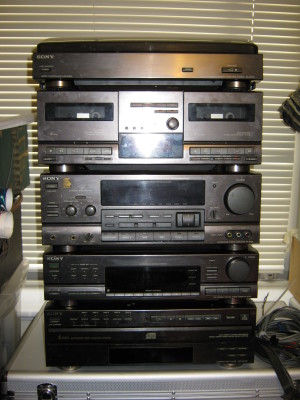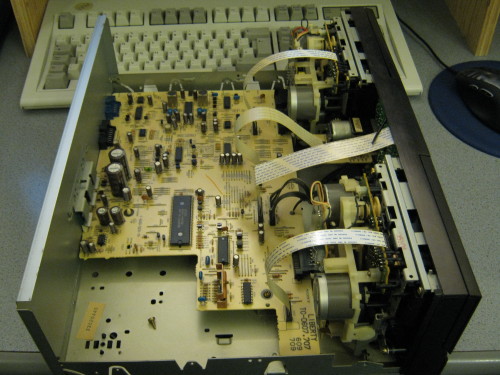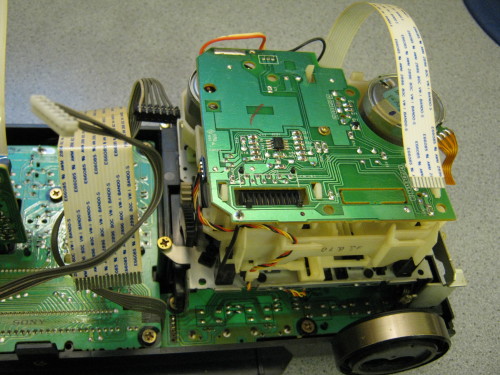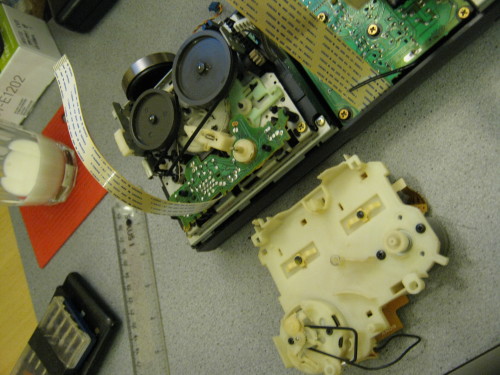I've recently been digitising my family's cassette tapes. I ran into a problem with a box of family tapes that'd been played over and over again on cheap tape players, and were badly worn, stretched, and generally chewed up. My Aiwa AD-S950 deck, which generally does a good job of playback, has a dual-capstan mechanism with some logic to sense the tape tension, and it'll stop playback to avoid damaging the tape if it detects something's wrong. This is usually a good idea, but these beaten-up tapes would only play for a few seconds before triggering the mechanism to stop.
So I needed a tape deck that was a bit less intelligent, but still had reasonable playback quality — and ideally at minimal cost. My local auction house occasionally has hi-fi gear, and this pile turned up in early March:
This is a Sony LBT-D609 integrated system from the early 1990s, which is sort of like a midi system in separate boxes: the tape deck, tuner and amplifier share a single power supply, and are connected together with a power/control/audio bus. The tape deck is a Sony TC-D709, with a pair of single-capstan, 2-head auto-reverse mechanisms — exactly what I was after.
Electronically it was in working order, but when I tried to play a test tape, the tape spools didn't move. Time to have a look inside...
Typical 1990s Sony construction — they don't make single-sided PCBs like that any more — with a pair of near-identical cassette mechanisms. As I expected, the motors were turning but the 20-year-old rubber drive belts had disintegrated.
Sony's service manuals are generally pretty good. I couldn't find a free copy of the TC-D709 service manual online, but the PCB has several model numbers on it that I could search for, and Elektrotanya had the service manual for the TC-D707, which is the same device but without Dolby C. This revealed that the TCM-190RA12C and TCM-190RB12C tape mechanisms in this deck are a standard Sony design, used in at least the TC-D607, TC-D707, TC-D609, TC-D709, TC-H1600 and TC-WR590 — so if you've found this page because you've got any of those decks, these notes should apply to you as well.
Getting at the belts turned out to be pretty simple. First, you unscrew the front panel from the base, disconnect all the ribbon connectors, and pull the front panel away from the PCB:
Then you unplug the connector for the tape heads from the side of the deck PCB (in the photo above, this is blue with four thin wires twisted together), and undo the three screws holding the plastic "base block" to the front of the mechanism. You can then unclip and lift away the base block:
The belts will fall off when you do this. There are some plastic pillars that you can hook the belts around before reassembly in order to get them around the pulleys.
Having cleaned the gunk from the disintegrated belts off of the pulleys, the next job was to find some replacement belts. This is complicated by the multiple standards for specifying belt sizes: you can measure the length, or the length when folded flat (i.e. half the circumference), or the inner diameter, or the outer diameter...
I started by roughly measuring the existing belts, bearing in mind that they'd probably stretched a bit: the flat belt for the capstan was 4mm wide and 226mm circumference, and the square fast-wind belt was 1mm² and 73mm circumference. The service manual wasn't very helpful, only giving Sony part numbers, and while several online suppliers will sell you a complete kit of belts for several of the decks listed above, they also want to charge somewhere around £20 — which is silly money for four rubber bands!
A better bet is belt manufacturer Russell Industries, who have a handy cross reference guide listing appropriate drive belts for a wide selection of audio equipment. Running down my list of similar decks, I found a listing for the TC-WR590 suggesting the Russell FR8.2 (4mm wide, 207mm circumference) and SCX2.9 (1.2mm², 73.5mm circumference) — a reasonably good match for the existing belts.
My preferred UK supplier CPC don't have the full range of belts in Russell's catalogue, but I could get pretty close. CPC's AVBELT4 is 3mm wide and 212mm circumference, and AVBELT62 is 1.2mm² and 74mm circumference. A complete set of belts, postage included, came in at under £3.
I fitted the replacement belts and reassembled the deck. For testing, it's very useful to have a cassette shell with no tape in, and a cassette with tape in that you don't care about — in case a belt falls off and it ends up wrapped around the capstan! The only caveat here is that the 1.2mm² belt (that the Russell guide suggests) is really too wide for the pulleys, and won't self-centre properly if there's any sort of twist in the belt. It works if it's carefully centred in the groove, but if I've still got this deck in 20 years' time, I'll be looking for a 1mm² replacement.
After a final clean of the tape path, the deck worked happily and I was able to digitise the remainder of the problematic tapes.
If you're fixing one of these decks, you should also have a look at phila's TC-WR590 repair article, which has some nice photos of the deck and describes how to clean off sticky belts.



